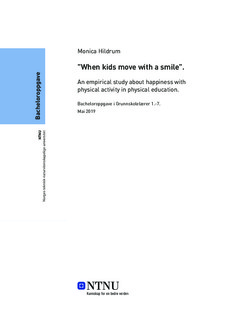| dc.contributor.advisor | Sundan, Jon | |
| dc.contributor.author | Hildrum, Monica | |
| dc.date.accessioned | 2019-08-23T14:06:22Z | |
| dc.date.available | 2019-08-23T14:06:22Z | |
| dc.date.issued | 2019 | |
| dc.identifier.uri | http://hdl.handle.net/11250/2610177 | |
| dc.description.abstract | I denne oppgaven rettes det fokus mot bevegelsesglede i kroppsøvingsfaget. Oppgavens problemstilling er: «Hvordan definerer tre lærere på mellomtrinnet begrepet bevegelsesglede og hvordan tilrettelegger de for bevegelsesglede hos barn i kroppsøvingsundervisningen?» For å finne svar på problemstillingen valgte jeg en kvalitativ metode og intervjuet tre lærere på mellomtrinnet. Deres forståelse av begrepet, samt deres tanker rundt tilrettelegging for dette i kroppsøvingsfaget, danner grunnlaget for oppgaven. Oppgavens teoriforankring rundt begrepet er hentet fra Kathrine Bjørgens (2017) doktoravhandling «Bevegelsesglede i barnehagen» og Idar Lyngstads kapittel «Bevegelsesgleden i kroppsøving» (2010). Videre er det benyttet flere teorier for å finne svar på hvordan man kan tilrettelegge for bevegelsesglede hos barn i kroppsøvingsundervisningen. Ulike motivasjonsteorier er blitt brukt for å få en forståelse for dette. Teoriene om Indre- og ytre motivasjon, flyt, målorientering og mestringsforventning er benyttet. Videre er lek, fysisk-motorisk ferdighetsutvikling og tilpasset opplæring med i oppgaven som sentrale holdepunkt for å tilrettelegge for bevegelsesglede hos barn.
Ut i fra mine funn ser det ut til at leken har en sentral rolle når det kommer til å tilrettelegge for bevegelsesglede hos barn i kroppsøvingstimene. Videre er det å tilpasse undervisningen etter elevenes ulike evner og forutsetninger viktig for at alle skal kunne føle på mestring. På en annen side kan elevens motivasjon for faget og de aktivitetene de skal gjennomføre være avgjørende for om de oppnår bevegelsesglede. Variasjon i undervisningen vil være viktig for å fenge flest mulig, men likevel ser det ut til at elevene samtidig må få god nok tid med oppgavene de blir satt til for å kunne mestre og å oppleve bevegelsesglede. Elevenes opplevelse av autonomi virker å spille en viktig rolle, samt deres tidligere erfaringer rundt det å mestre eller ikke mestre bestemte oppgaver. | |
| dc.description.abstract | My focus in this assignment is about happiness with physical activity in Physical Education. The issue is: «How does three teachers in middle school define the term happiness with physical activity, and how do they arrange for it when teaching Physical Education?”
To find an answer to the issue I chose a qualitative method and interviewed three teachers in middle school. Their understanding of the term, as well as their thoughts about arrangements is the foundation for this assignment. The assignments theoretical foundation is taken from Kathrine Bjørgens doctorate «Happiness with physical activities in kindergarten» (2017) and Idar Lyngstads chapter «Happiness with physical activity in Physical Education» (2010).
I have used different motivational theories to find an answer to how we can arrange for happiness with physical activity for children when teaching Physical Education. Different motivational theories have been used to understand this. The theories about inner- and outer motivation, flow, goal orientation and expectation about mastering has been used. Further on play, physical-motorial evolvement of skills and adjusted training are in the assignment as central clues to arrange for happiness with physical activity for children.
From my findings I can clearly see that playing has a central role when it comes to arranging for happiness with physical activity for children in Physical Education. It is also important to adjust the teaching after the kid’s abilities and conditions, so that they can feel that they are mastering the subject. In another hand the student’s motivation for the subject and the activities they are supposed to carry out, can be decisive for if they can achieve happiness with physical activity. Variations in teaching are important to capture most of the kids, but still it seems like the students need to have enough time for each assignment to feel that they have mastered it and to achieve happiness with physical activity. The students feeling of autonomy seems to be decisive, as well as their former experiences when it comes to mastering or not mastering specific tasks. | |
| dc.language | nob | |
| dc.publisher | NTNU | |
| dc.title | "Når barna beveger seg med et smil" En empirisk studie om bevegelsesglede i kroppsøving. | |
| dc.type | Bachelor thesis | |
